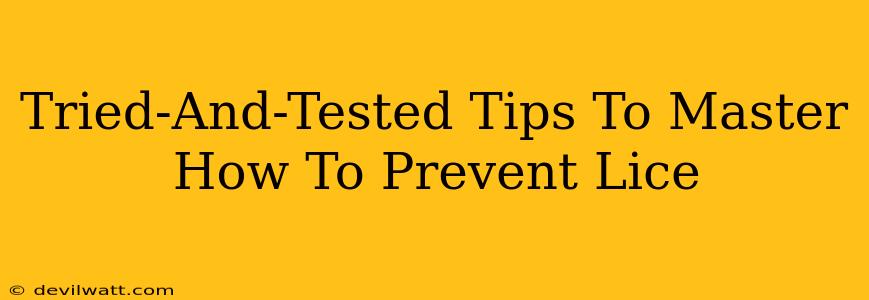Head lice. Just the words can send shivers down a parent's spine (or anyone who's ever experienced an infestation!). These tiny parasites are incredibly common, and while not dangerous, they're incredibly annoying and persistent. The good news? Preventing lice is entirely possible with the right knowledge and proactive strategies. This guide provides tried-and-tested tips to help you master lice prevention and keep those pesky critters away.
Understanding Your Enemy: Head Lice
Before diving into prevention, let's quickly understand what we're up against. Head lice are wingless insects that live and feed on human blood. They spread primarily through direct head-to-head contact, although they can sometimes be transmitted via shared hats, combs, brushes, or other personal items.
Key Characteristics of Head Lice:
- Highly contagious: Direct contact is the most common transmission method.
- Small and difficult to spot: Adult lice are about the size of a sesame seed.
- Itchy scalp: Their bites cause intense itching, a primary symptom of infestation.
- Nits (eggs): These are tiny, white or light-brown oval-shaped eggs firmly attached to hair shafts.
Tried-And-Tested Prevention Strategies:
Now that we know the enemy, let's arm ourselves with effective prevention methods. These strategies focus on minimizing the risk of contact and making your head a less hospitable environment for lice.
1. Regular Hair Checks:
The cornerstone of prevention is vigilance. Regularly check your child's (and your own!) hair for lice and nits. Part the hair in small sections and examine the scalp closely, paying particular attention to the hairline and behind the ears. A fine-toothed comb can help detect nits that might be missed with the naked eye. Make this a routine part of your weekly hygiene checks.
2. Avoid Head-To-Head Contact:
This may seem obvious, but limiting direct head-to-head contact with others is crucial. Encourage children to avoid close contact during playtime, especially in crowded areas like schools or playgrounds.
3. Don't Share Personal Items:
This is a big one. Emphasize the importance of not sharing hats, scarves, combs, brushes, headphones, or other personal items that might come into contact with the hair and scalp.
4. Proper Hair Hygiene:
While regular washing doesn't kill lice, it can help to remove loose nits and keep the hair clean. Choose a shampoo and conditioner that suits your hair type.
5. Use a Nit Comb Regularly:
Even if you don't see any lice, regular use of a fine-toothed nit comb can help remove any loose nits or eggs before they hatch. This is particularly helpful after playing with other children or participating in activities where head-to-head contact might occur.
6. Teach Children About Lice Prevention:
Educate your children about the importance of good hygiene and lice prevention. Make it a fun and interactive learning experience.
Addressing Potential Outbreaks:
Even with the best preventative measures, lice infestations can still occur. If you suspect an infestation, act quickly. Early detection and treatment are key to minimizing the spread and discomfort. Consult your doctor or pediatrician for guidance on treatment options.
Conclusion: Proactive Prevention is Key
Mastering how to prevent lice is a combination of vigilance, good hygiene practices, and smart habits. By implementing these tried-and-tested tips, you can significantly reduce the risk of head lice infestations and keep your family happy and itch-free! Remember, consistent effort and proactive measures are your best defense against these persistent pests.

